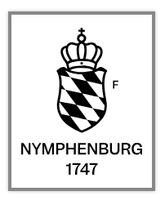Изготовитель Нимфенбург Nymphenburg
Купить фарфор Нимфенбург Nymphenburg. Продажа фарфоровых изделий на art-picture.ru
- Вначале высокая цена | низкая цена
Изготовитель Нимфенбург Nymphenburg

Нимфенбургская мануфактура (Nymphenburg) в Баварии — одна из самых старых фабрик по производству фарфора в Европе. Она открылась в 1747 году в Мюнхене и продолжает работу в наши дни. Характерная черта Нимфенбургской мануфактуры — до сих пор сохранившееся ручное производство посуды, ваз и статуэток. Еще один секрет ее успеха — яркая и богатая палитра красок собственного изготовления. Мастера наносят их вручную подглазурным способом. В лаборатории фабрики умеют создавать 50 тысяч сочетаний пигментов, благодаря чему расписные изделия превращаются в изысканные произведения искусства.
История фарфорового производства Nymphenburg в XVIII и XIX веках
Нимфенбургская мануфактура начала работу при поддержке королевского дома Виттельсбахов. Курфюрст Баварии Максимилиан III способствовал открытию новых производств для укрепления экономики. Фабрика с формовочными цехами и художественными мастерскими была основана 11 ноября 1747 года. На отладку производственных процессов и подготовку первых моделей ушло еще несколько лет, ведь владельцы с самого начала были нацелены на создание фарфора высочайшего качества. Для этого к сотрудничеству привлекали профессиональных скульпторов и художников.
Нимфенбургская мануфактура пригласила скульптора Франца Антона Бустелли (Francesco Antonio Bustelli), работавшего в стиле рококо. Он изготовил серию фарфоровых статуэток с персонажами итальянской комедии дель арте. С 1756 года окрашенный фарфор начал выпускаться на постоянной основе, и вскоре предприятие стало коммерчески успешным. На смену Бустелли через несколько лет пришел другой известный скульптор — Доминик Авличек (Dominikus Aulicheck), создавший около ста моделей фигурок. Его сменил Иоганн Петер Мельхиор (Johann Peter Melchior). К концу XVIII века важным заказчиком для фабрики стал король Баварии Людвиг I.
К середине XIX века времена процветания сменились глубоким экономическим кризисом. Мануфактура была приватизирована, и вынужденно перешла на технический и медицинский фарфор вместо художественного. Постепенно посуда тоже вернулась в ассортимент: ее заказывали монастыри, гостиницы, больницы и воинские части. Нифенбургская мануфактура в XX веке и в наши дни
В начале XX века купец Альберт Боймль (Albert Bäuml) берет производство в аренду, рассчитывая возродить немецкое фарфоровое искусство XVIII столетия. Он собирает коллекцию старинных изделий, начиная со статуэток Бустелли, и запускает их повторный выпуск. Также предприниматель пригласил новых художников, создававших элегантную посуду в стиле модерн. Высоко ценятся фигурки животных, созданные в этот период мастерами Теодором Кернером (Theodor Körner) и Вилли Цюгелем (Willy Zügel). Заказчиками Нимфенбургской мануфактуры становятся аристократы, посольства, церкви и дворцы разных стран.
В годы Второй Мировой войны фабрика использовалась для военных нужд и стала целью бомбардировок. Она была разрушена, но самые ценные модели, формы и образцы старинного фарфора уцелели в подвалах. После войны семья Боймль возобновляет производство. В настоящее время фабрикой владеет принц Луитпольд Баварский. Как и в прежние времена, мануфактура привлекает к сотрудничеству известных дизайнеров Европы и Америки. Вот несколько художников, работавших в Нимфенбурге в XXI веке: Константин Грчич (Konstantin Grcic); Хелла Йонгериус (Hella Jongerius); Кики Смит (Kiki Smith); Юп ван Лисхаут (Joep van Lieshout); Олаф Николай (Olaf Nicolai); Карстен Хеллер (Carsten Höller).
Фарфор Nymphenburg высоко ценится среди коллекционеров. Если вы принадлежите к их числу, то найдете много интересного на сайте Very Important Lot! У нас регулярно проходят аукционы, где можно приобрести редкий антиквариат и произведения искусства.

